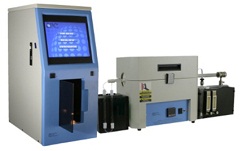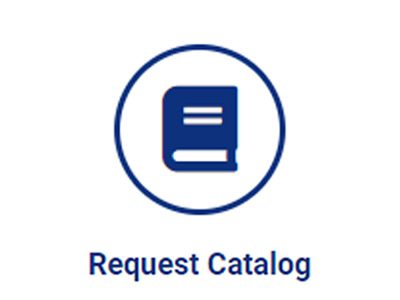TOTAL CARBON (TC) AND TOTAL ORGANIC CARBON (TOC) IN WATER USING HIGH TEMPERATURE COMBUSTION
PRINCIPLES OF OPERATION
Water samples are injected directly into a 950oC combustion zone. Oxygen carries the combustion product gases through a barium chromate catalyst/scrubber to ensure all of the carbon has been oxidized to CO2. Interfering combustion gases such as HCl, SO2 and SO3 are removed by the barium chromate. Other scrubbers remove all potentially interfering gases, such as HBr, Hl and NOX, before the CO2 containing gas stream is swept into the CO2 Coulometer for detection. All scrubbers have sufficient capacity to allow for the analysis of mineral acids.
If Total Organic Carbon (TOC) is to be determined directly, dissolved CO2 and inorganic forms of carbon must be removed from the sample prior to injection. Acidification and sparging of the sample is an effective pretreatment for removal of non-organic components. Alternately, TOC can be determined by difference between Total Carbon (TC) and Total Inorganic Carbon (TIC) determinations.
PROCEDURES
TOTAL CARBON ANALYSIS
- Assemble and prepare the components for operation as described in the Instruction Manuals.
- Determine the blank and run a standard to confirm propoer operation of the complete system.
- Fill the spring-loaded syringe with 200ul of sample solution and insert the syringe into the sample introduction port.
- Allow approximately one (1) minute for the system to purge any atmospheric CO2.
- Inject the sample and begin the analysis by pressing “Enter” on the CM5017 CO2 Coulometer.
- When all of the CO2 has been evolved and titrated, the CM5017 automatically detects the endpoint, ends the analysis and prints the result to the printer and/or diskette.*
(*) – Endpoint determination and result calculations are performed automatically based on user selectable settings entered into the CM5017 CO2 Coulometer.
TOTAL ORGANIC CARBON ANALYSIS
- Assemble the components (including the purge accessory) and prepare them for the operation as described in the Instruction Manuals.
- Determine the blank and run a standard to confirm proper operation of the system.
- Fill a test tube (or some other appropriate container) with about 5ml of sample.
- Acidify the sample to approximately pH 2.
- Purge the acidified sample for 6 to 12 minutes on the purge accessory with the oxygen flow at 50-100 cc/minute.
- Fill the syringe and inject the sample as described in “Total Carbon Analysis” above.
NOTE: If the samples contain large amounts of salts or particulates, it may be desirable to use the Ladle Introduction Components which permit the introduction of samples in boats or capillary tubes. Direct injection of samples in simpler and faster, but allows salts to attach the quartz combustion tube. Placing the samples in boats permits mixing of the sample with tungsten trioxide (WO3) which minimizes the salts’ contact with the combustion tube. WO3 also eliminates the formation of carbonates that can lengthen the anaylsis time and increase the instrument blank.
For samples containing low to medium salt concentrations, it is advisable to mix WO3 in the loosely packed quartz wool placed in the combustion tube before the barium chromate.
RESULTS
When 200ul of sample is injected, up to 20,000 mg C/L may be determined without requiring dilution. Accuracy is typically +/-0.5% relative for samples containing more than 500 ppm C. For low concentrations, the accuracy is limited by the blank consistency. Accuracy can be as good as +/-0.5 mg C/L for potable waters. At high levels, accuracy is limited by the volume measurement and may be improved byt weighing the syringe before and after the injection. Analysis times vary with the concentrations being determined and the accuracy sought with 3 to 5 minutes being typical.
OTHER INFORMATION
Additional details about this method are included in the ASTM D 4129-88 “Standard Test Method for Total and Organic Carbon in Water Oxidation by Coulometric Detection”. The method is under jurisdiction of Committee D19.06 and is available from ASTM.
For additional information about the instrument’s capabilities for specific types of samples, contact the UIC, Inc. Applications Laboratory.





